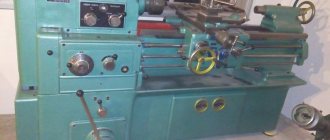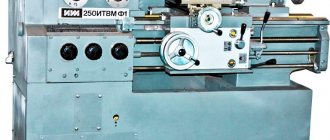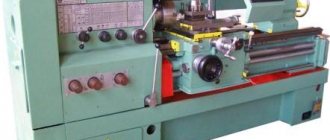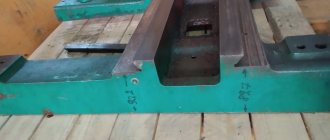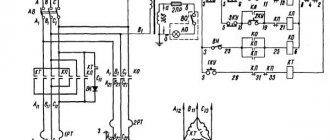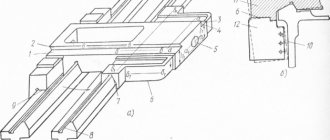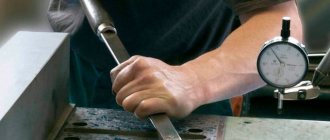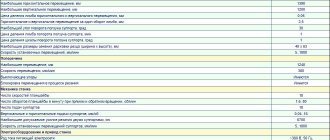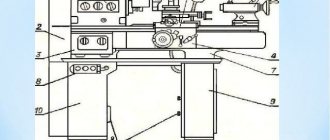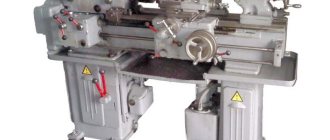Using any screw-cutting lathe, which can be used to process both metallic and non-metallic parts, turning operations are carried out.
External thread cutting
Structural elements of lathe-screw-cutting machines
Any screw-cutting lathe, belonging to the category of universal equipment, allows you to perform the following types of processing of parts made of various materials:
- opening holes;
- turning and boring surfaces of various configurations: shaped, conical, cylindrical;
- performing countersinking and drilling;
- end processing and trimming;
- cutting threads of various types.
A universal screw-cutting lathe of any model consists of standard components and mechanisms, which include:
- machine support;
- front and rear stock;
- box providing speed control;
- supporting frame;
- spindle;
- electrical equipment;
- equipment cabinets;
- guitar gears;
- running roller;
- equipment apron;
- box providing selection and change of feeds;
- The main element of a screw-cutting lathe, which distinguishes it from a conventional turning model, is the lead screw.
What is typical is that the structural elements of screw-cutting lathes of different models not only have the same name, but also the same location. For example, machines of this category, produced by different manufacturers (including those with numerical control), are almost identical in design.
Main components of a screw-cutting lathe
To ensure control of all working systems, screw-cutting lathes are equipped with various handles and levers. These include, in particular:
- a handle used to change the spindle rotation speed;
- control body responsible for selecting the parameters of the thread being cut (pitch and feed);
- a handle responsible for selecting the pitch category of the thread being cut - increased or normal;
- a control element that determines the direction of movement of the slide (longitudinal or transverse);
- handle for controlling the upper slide;
- a control element for enabling and disabling the rotation of the lead screw;
- a control element for selecting the direction of the thread to be cut;
- turning on and off the main engine;
- an element responsible for fixing the quill and automatically starting the longitudinal feed;
- the so-called steering wheel, which is responsible for the movement of the quill;
- feed parameters control body;
- control of caliper movement parameters;
- element responsible for fixing the tailstock;
- control element for the direction of movement of the spindle, as well as its stop.
Screw-cutting lathe 1K62
What operations can be performed?
A large-scale or benchtop screw-cutting lathe is installed to form shaft or flange type parts. The cutting tool is a through cutter, which is selected according to the cutting conditions.
Shafts Flange
In addition, there are scoring cutters that can be used for processing end surfaces. The formation of grooves is carried out when installing thrust-type cutters. Different types of cutters are used to perform certain operations. In this case, attention is paid to the shape, as well as the type of material used in manufacturing. A precision screw-cutting lathe also allows you to carry out basic types of work.
Some types of this equipment can also be used to perform drilling operations. But it is worth considering that in this case the drill is located along the axis of the workpiece. The principle of operation of this drilling scheme is as follows: the tool is mounted in a special equipment on the tailstock, is in a stationary state, and the workpiece itself receives rotation. The tailstock can be moved longitudinally to perform feed.
Classification of universal lathes
Types of screw-cutting lathes are distinguished depending on several parameters, which include:
- weight of equipment;
- the maximum length of the part allowed for processing on a screw-cutting lathe;
- the maximum diameter of such a part.
The length of a part processed on a screw-cutting lathe of one model or another depends on the distance maintained between its centers. If we consider the diameter of the workpiece, which can be processed by a specific universal screw-cutting lathe, then this parameter is in the range from 100 to 4000 mm. It should be borne in mind that machine models that can process parts of the same diameters may differ in the length of the workpieces processed.
Heavy screw-cutting lathe 1A670
Universal lathes can have different weights. So, according to this parameter, equipment is classified into one of the following categories:
- heavy machines, the weight of which can reach up to 400 tons (screw-cutting lathes of this category can process parts with a diameter of 1600–4000 mm);
- machines weighing up to 15 tons (such equipment can process parts with a diameter of 600–1250 mm);
- equipment weighing up to 4 tons (with a permissible diameter of processed parts of 250–500 mm);
- lightweight machines whose weight does not exceed 0.5 tons (such equipment can process parts with a diameter of 100–200 mm).
A lightweight universal lathe is a benchtop model that is typically used in home workshops or small businesses.
Screw cutting lathe CU500
The most common types of enterprises with such screw-cutting lathes are:
- experimental sites of enterprises in various industries;
- enterprises engaged in the production of watch movements;
- factories producing instruments and control equipment.
Enterprises in the energy and mechanical engineering industries are equipped with heavy-duty screw-cutting lathes. Devices of this type are also used for processing elements of special mechanisms and assemblies - parts:
- turbine mechanisms;
- for equipping railway transport (wheel sets, etc.);
- for completing heavy rolling equipment.
However, screw-cutting lathes belonging to the middle category are most widespread. It is through the use of such machines that it is possible to perform semi-finishing and finishing metalworking operations, as well as cut threads of various categories.
A universal lathe, which belongs to the middle category, has a number of significant advantages: a wide range of working tool feeds and spindle speeds, high structural rigidity and engine power, which allows you to perform a wide range of work with workpieces made of metal and other materials.
Medium-category screw-cutting lathes, in addition, are equipped with various mechanisms and devices that significantly expand their functionality, allow processing with greater precision, and make the work of operating personnel more comfortable and safe. Such elements of additional equipment, which is convenient, allow you to automate many processes of processing workpieces on screw-cutting lathes.
Separately, it should be said about screw-cutting lathes with numerical control (CNC), which in Soviet times were produced simultaneously by several enterprises. As a rule, enterprises that produced a large range of small-scale products were equipped with such machines. The design of a screw-cutting lathe of this type and the possibility of its quick changeover make it simply irreplaceable in situations where it is necessary to quickly switch to the production of parts of a different modification.
Screw-cutting lathe 1M63
Types of equipment
Lathes are classified according to a number of parameters, primarily by purpose, versatility or specialization of the equipment, and by its design features. They are also divided according to:
- accuracy class when processing a part;
- automation;
- weight;
- engine power and other parameters.
According to the current classification in the Russian Federation, there are the following types of lathes:
- single- and multi-spindle automatic and semi-automatic machines;
- cutting;
- screw-cutting;
- revolver;
- carousel;
- frontal;
- specialized;
- special.
Basic technologies for processing parts on screw-cutting lathes
Lathe equipment is typically used to machine external cylindrical surfaces. In such situations, a through cutter is used as a tool. The allowance along the length of the workpiece is usually from 7 to 12 mm. This size reserve is necessary so that the workpiece can be cut to the required length and its ends processed.
To trim the end of the workpiece, several types of cutters can be used - thrust, straight through and scoring. To perform trimming and grind small ledges on a part, thrust-type cutters are used.
A universal lathe also allows you to cut grooves of varying depths on parts. For these purposes, a special groove tool is used, and the procedure itself is carried out at low spindle speeds.
Cutting the finished product is carried out according to a similar principle. The cutting process is completed at the moment when the diameter of the jumper at the cutting site reaches a value of the order of 2–2.5 mm. At this point, the cutting process stops, and the finished part is simply broken off from the workpiece.
Additional selection criteria
After studying the seller's catalog, you can note several models with similar characteristics and functionality. The following criteria help you make your final choice:
- manufacturer. The bulk of lathes presented in Russian stores are domestic instruments, as well as devices manufactured in Europe and China. The products of European companies are of the highest quality and reliability, but are expensive. Russian and Chinese machines represent a reasonable compromise between price and capabilities. They are quite reliable and suitable for solving many typical problems;
- warranty and service. Even the most reliable tool sometimes breaks. A fairly large and heavy device cannot easily be sent by mail to another city or country. You should also pay attention to the availability and cost of components;
- additional options. Some machine models are equipped with devices that do not directly affect the functionality of the device, but significantly facilitate the processing of parts. These options include work area illumination;
- reliability of operation. In some cases, outstanding technical characteristics do not correspond to the actual operation of the device. If the seller offers to personally test the machine in action and thereby demonstrate all the capabilities of the model, you need to take advantage of this opportunity. The tool must work stably in all modes. In this case, there should be no extraneous vibrations or noise.
A lathe is an indispensable tool for the home workshop. Tools intended for household use are cheap and compact in size, but at the same time quite functional. They allow the same operations with rotating metal parts as their industrial counterparts.
Overview and diagrams of common models
Among the diverse model range and several generations of machines that are produced by our production, there are several models that continue to be popular for their technical characteristics and universal properties.
All of them are used in production or in domestic conditions to this day. At the same time, they continue to be worthy competitors to foreign analogues.
These are reliable, durable and durable devices capable of performing a huge number of different functions.
1L532
One of the most popular machines in the former USSR, which can successfully process workpieces of medium and large sizes.
At one time, this equipment was successfully exported to many countries around the world. Accuracy class – N. Machine weight – 43 tons.
16U04P
High precision equipment. The largest diameter of the part processed above the bed is 200 mm. Machine weight – 750 kg.
1P611
A machine used in production, including for turning wheels of railway vehicles. According to GOST, they are distinguished by increased accuracy and have the ability to brake the spindle. Device weight 560 kg. Easily performs the following functions:
- Drilling.
- Segment.
- Cutting internal and external threads.
- Treatment of various surfaces.
The largest diameter of the workpiece above the bed is 250 mm.
1D601
This machine is better suited for purely domestic use. The accuracy is lower than the previous machine. It features high performance even after many years of operation.
Moving the caliper is only possible manually. The weight of the entire machine is about 30 kg. Due to the small dimensions, the maximum length of the workpiece to be processed is 18 cm.
16K40
One of the most popular models that has really gained popularity among craftsmen. Belongs to the middle class of equipment with accuracy class N.
Since 1932, several tens of thousands of various screw-cutting lathes have been produced in the USSR. They were used not only in production, but also for training young people, in schools, colleges, and many had desktop machines in garages, homes, and their own workshops.
Such equipment will help to bore a hole, level the required surface, or drill an existing hole.
It is important, focusing on the initial specifications of the equipment, to purchase the most suitable model
How to become a metalworking professional
Training in turning, as, for example, in the profession of a doctor, lasts a whole life, in addition to a significant amount of theoretical information, books and practical skills that need to be mastered, there is a constantly updated fleet of equipment that requires study, lathes are developing. The range of processed materials is also increasing, and new composite and polymer materials with unstudied properties are appearing.
Download turning tutorial
Lessons in turning and metal processing from more experienced colleagues and teachers can help in mastering the profession. Now a library of technical literature on metal processing has become available on the Internet: reference books, turner’s manuals and textbooks. Additional education requires time, which is always in short supply, and money, which will also not be superfluous, but these costs will more than pay off in the future.
